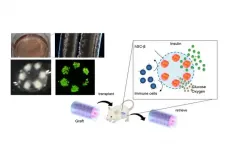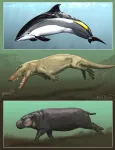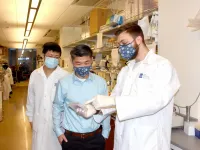Replacing what was lost: A novel cell therapy for type I diabetes mellitus
2021-04-01
(Press-News.org) Tokyo, Japan - Type I Diabetes Mellitus (T1D) is an autoimmune disorder leading to permanent loss of insulin-producing beta-cells in the pancreas. In a new study, researchers from The University of Tokyo developed a novel device for the long-term transplantation of iPSC-derived human pancreatic beta-cells.
T1D develops when autoimmune antibodies destroy pancreatic beta-cells that are responsible for the production of insulin. Insulin regulates blood glucose levels, and in the absence of it high levels of blood glucose slowly damage the kidneys, eyes and peripheral nerves. Because the body loses the ability to produce insulin over time, the current mainstay of treatment for T1D is to inject insulin. An exciting research endeavor over the past decade has been to find ways to replace lost beta-cells by means of cell therapy.
"Cell therapy is an exciting, but challenging, approach to treat type I diabetes mellitus," says lead author of the study Professor Shoji Takeuchi. "The challenge arises from the difficulty to make large amounts of human beta-cells in a dish, and more importantly, to achieve safe and effective transplantation. In this study, we wanted to develop a novel construct that enables successful transplantation of beta-cells in the long-term."
To achieve their goal, the researchers developed a lotus-root-shaped cell-encapsulated construct (LENCON) and packaged it with human iPSC-derived pancreatic beta-cells, which are a limitless cell source and allow for the production of any number of beta-cells. The necessity for such an encapsulation technique arises from the fact that immune cells of the recipient could destroy the newly transplanted cells. To prevent this from happening, the researchers constructed the LENCON graft with millimeter thickness. The millimeter-thick graft diameters have previously been shown to mitigate the body's immune response to a foreign body. At millimeter thickness, oxygen and nutrients could not be supplied to the center of the cells, but by using a lotus root shape, the cells were placed only near the edge of the graft where oxygen and nutrients can diffuse sufficiently, creating an environment in which the cells could survive, even in the millimeter-thick graft.
Having designed the LENCON, the question was if it would effectively control blood glucose levels in the long-term without provoking an immune response. To address this question, the researchers transplanted the construct in immunodeficient and immunocompetent diabetic mice. The former helped investigate the efficacy of the graft on controlling blood glucose levels in the absence of an immune response, while the latter approach tackled both goals. The researchers found that LENCON was able to maintain normal blood glucose levels for more than 180 days in the former mice, and was able to be removed without adhesion after more than one year of transplantation in the latter mice.
"These are striking results that show how LENCON can successfully and safely be used in the setting of type I diabetes mellitus. Our results suggest that LENCON could offer a novel option for cell therapy for type I diabetes mellitus," says the first author of the study Dr. Fumisato Ozawa.
INFORMATION:
The article, "Lotus-root-shaped cell-encapsulated construct as a retrieval graft for long-term transplantation of human iPSC-derived β-cells" was published in iScience at DOI: 10.1016/j.isci.2021.102309
About Institute of Industrial Science (IIS), the University of Tokyo
Institute of Industrial Science (IIS), the University of Tokyo is one of the largest university-attached research institutes in Japan.
More than 120 research laboratories, each headed by a faculty member, comprise IIS, with more than 1,000 members including approximately 300 staff and 700 students actively engaged in education and research. Our activities cover almost all the areas of engineering disciplines. Since its foundation in 1949, IIS has worked to bridge the huge gaps that exist between academic disciplines and realworld applications.
[Attachments] See images for this press release:

ELSE PRESS RELEASES FROM THIS DATE:
2021-04-01
A new study shows that the similarly smooth, nearly hairless skin of whales and hippopotamuses evolved independently. The work suggests that their last common ancestor was likely a land-dwelling mammal, uprooting current thinking that the skin came fine-tuned for life in the water from a shared amphibious ancestor. The study is published today in the journal Current Biology and was led by researchers at the American Museum of Natural History; University of California, Irvine; University of California, Riverside; Max Planck Institute of Molecular Cell Biology and Genetics; and the LOEWE-Centre for Translational Biodiversity Genomics (Germany).
"How mammals left terra firma and became fully aquatic is one of the most fascinating evolutionary ...
2021-04-01
PHILADELPHIA -- (April 1, 2021 -- Scientists at The Wistar Institute identified a new mechanism of transcriptional control of cellular senescence that drives the release of inflammatory molecules that influence tumor development through altering the surrounding microenvironment. The study, published in Nature Cell Biology, reports that methyltransferase-like 3 (METTL3) and 14 (METTL14) proteins moonlight as transcriptional regulators that allow for establishment of the senescence-associated secretory phenotype (SASP).
Cellular senescence is a stable state of growth arrest in which cells stop dividing but remain viable and produce an array of inflammatory and growth-promoting molecules collectively defined as SASP. These molecules account ...
2021-04-01
The University of Maryland (UMD) has collaborated with Cornell University and Stanford University to quantify the man-made effects of climate change on global agricultural productivity growth for the first time. In a new study published in Nature Climate Change, researchers developed a robust model of weather effects on productivity, looking at productivity in both the presence and absence of climate change. Results indicate a 21% reduction in global agricultural productivity since 1961, which according to researchers is equivalent to completely losing the last 7 years ...
2021-04-01
ITHACA, N.Y. - Despite important agricultural advancements to feed the world in the last 60 years, a Cornell-led study shows that global farming productivity is 21% lower than it could have been without climate change. This is the equivalent of losing about seven years of farm productivity increases since the 1960s.
The future potential impacts of climate change on global crop production has been quantified in many scientific reports, but the historic influence of anthropogenic climate change on the agricultural sector had yet to be modeled.
Now, a new study provides these insights: "Anthropogenic Climate Change Has Slowed Global Agricultural Productivity ...
2021-04-01
Many wildlife species are threatened by shrinking habitat. But according to new research, the potential range of African elephants could be more than five times larger than its current extent.
Due to 2,000 years of human pressure, African elephants have suffered dramatic population declines, and their range has shrunk to just 17% of what it could be, say researchers who led the new study, in Current Biology.
The dramatic reduction in range is due to the killing of elephants for their ivory and the encroachment of humans into elephant habitat. Evidence for elephants being ...
2021-04-01
Children hospitalized with breathing problems due to a common viral lung infection are likely to get sicker and remain hospitalized if they have high levels of defective copies of the virus, according to a new study by researchers at Washington University School of Medicine in St. Louis.
The findings, published April 1 in Nature Microbiology, could help doctors identify those patients at high risk of severe illness due to respiratory syncytial virus (RSV), the most common cause of pneumonia and bronchiolitis (inflammation of the small airways) in children under age 5.
"Every ...
2021-04-01
What The Study Did: This observational study examined death and hospital readmission rates of patients with COVID-19 pneumonia after being discharged to home or quarantine housing with supplemental home oxygen.
Authors: Brad Spellberg, M.D., of the Los Angeles County + University of Southern California Medical Center in Los Angeles, is the corresponding author.
To access the embargoed study: Visit our For The Media website at this link https://media.jamanetwork.com/
(doi:10.1001/jamanetworkopen.2021.3990)
Editor's Note: Please see the article for additional information, including other authors, author contributions and affiliations, conflict of interest ...
2021-04-01
What The Study Did: Researchers assessed changes in the number of views of articles published in three leading medical journals since the start of the COVID-19 pandemic.
Authors: Andrew J. Giustini, M.D., Ph.D., of the Stanford University School of Medicine in Stanford, California, is the corresponding author.
To access the embargoed study: Visit our For The Media website at this link https://media.jamanetwork.com/
(doi:10.1001/jamanetworkopen.2021.6459)
Editor's Note: Please see the article for additional information, including other authors, author contributions and affiliations, conflict ...
2021-04-01
What The Study Did: Nationally representative data were used to look at whether systolic and diastolic blood pressure levels among children and adolescents in the United States have changed during the past 20 years.
Authors: Shakia T. Hardy, Ph.D., of the University of Alabama at Birmingham, is the corresponding author.
To access the embargoed study: Visit our For The Media website at this link https://media.jamanetwork.com/
(doi:10.1001/jamanetworkopen.2021.3917)
Editor's Note: The article includes conflicts of interest and funding/support disclosures. Please see the ...
2021-04-01
BOSTON - New research reveals that when breast cancer cells spread to the brain, they must boost production of fatty acids, the building blocks of fat, in order to survive there. The work, which is published in Nature Cancer and was led by investigators at Massachusetts General Hospital (MGH) and the Koch Institute of the Massachusetts Institute of Technology (MIT), points to a potential new treatment target for shrinking brain tumors that arise secondary to breast cancer.
Therapies that target the human epidermal growth factor receptor 2 (HER2) have transformed treatment ...
LAST 30 PRESS RELEASES:
[Press-News.org] Replacing what was lost: A novel cell therapy for type I diabetes mellitus




